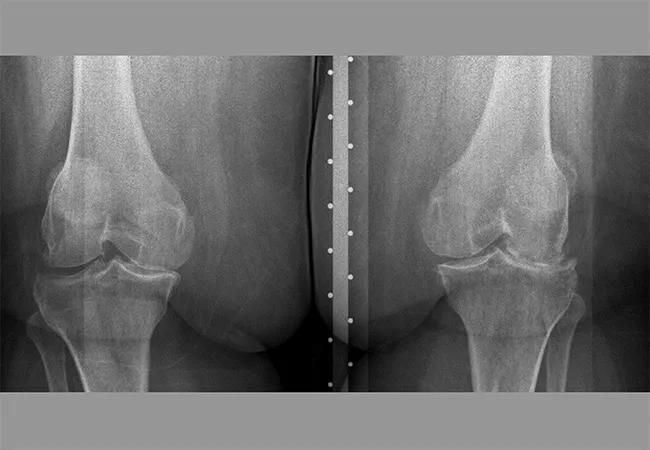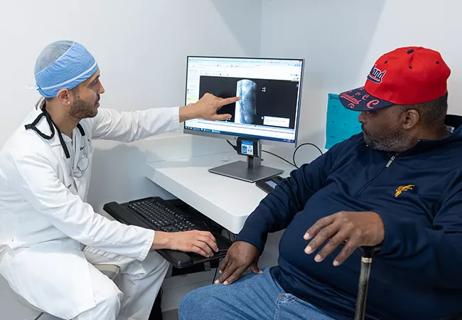New program bridges orthopaedics and endocrinology

Advertisement
Cleveland Clinic is a non-profit academic medical center. Advertising on our site helps support our mission. We do not endorse non-Cleveland Clinic products or services. Policy
“Osteobesity” is the intersection of osteoarthritis and obesity. Body mass index (BMI) is often a contributing factor in inflammation and joint wear and tear. To thoroughly treat joint conditions, weight loss should be addressed, especially when surgery is anticipated. Patients with BMI over 40 are at higher risk of poor surgical outcomes, including infection. Higher BMI also increases stress on the prosthesis, causing it to wear out sooner than joint replacements in patients with lower BMI.
Patients with poorly controlled diabetes mellitus also are more likely to have unfavorable outcomes of orthopaedic procedures. Those with hemoglobin A1c above 8% are at higher risk of infection after joint replacement (not just around the prosthetic, but also at the incision site) as well as elevated blood sugar after steroid injection.
However, optimizing patients with obesity or diabetes for orthopaedic interventions requires more than advising patients to modify their diet and increase exercise. Most patients don’t know how to do those things on their own. They could benefit from personalized coaching by their provider.
Prescribing a diet or exercise regimen should be similar to prescribing medication. Patients need the right dose of the right type of exercise — including the right stretching, resistance training, cardio training and recovery period — with the right fuel at the right time. Exercise is medicine. And the best exercise prescription is relative to each individual patient.
To better prepare patients for orthopaedic interventions, Cleveland Clinic’s Orthopaedic & Rheumatologic Institute introduced the Get Ready program in 2021. Patients with BMI of 40 or higher, or hemoglobin A1c above 8%, are fast-tracked to a specialized team in Cleveland Clinic’s Endocrinology & Metabolism Institute through a custom order set in Cleveland Clinic’s electronic medical record.
Advertisement
Orthopaedic providers specify:
The Endocrinology & Metabolism team then provides priority scheduling with obesity medicine and/or diabetes specialists.
The overall goal is to reduce patients’ risk of poor surgical outcomes. However, the Get Ready program also benefits patients not anticipating surgery, who simply want to improve their health to reduce symptoms of joint conditions.
Diet and exercise changes in this patient population aren’t easy and aren’t always successful. Joint pain, and the resulting immobility, adds extra complexity.
Providers in the Get Ready program overcome these challenges with resilience and a specialized understanding of physiology and bioenergetics.
Anti-obesity medications may be an initial step, until patients become able to sustain mobility and a meaningful caloric deficit. But increasing exercise capacity, building muscle and improving patients’ strength-to-weight ratio are key.
If a patient is too heavy to get up out of a chair and walk, a joint replacement won’t help. Leg muscles that are weak due to underuse only get weaker with downtime after surgery, especially if the patient is older and doesn’t build new muscle easily. Helping patients build muscle before surgery offsets the atrophy that naturally occurs after surgery. Providers in the Get Ready program understand how to achieve this while managing or preventing joint flare-ups.
Advertisement
There is no “standard” routine, but I often prescribe upper body exercise (e.g., chest press, seated row, shoulder press, bicep curl) because it will not worsen a patient’s knee or hip pain. I also may prescribe lower body exercise. While walking can put unwanted stress on knee and hip joints and cause pain, patients may be able to tolerate lifting weights with their legs (e.g., leg press, knee extension, hamstring curl) because exercise machines can control the external load. Patients typically perform three sets of 12-15 repetitions, and increase the weight slightly once they can perform 15 repetitions during all three sets.
I also encourage low-impact aerobic exercise, including aquatics, cycling and using elliptical machines, rather than walking or jogging on a treadmill. We try to gradually increase cardio by about 10% each week.
Between June 2021 and July 2022, 159 patients were referred for medical optimization through the Get Ready program (101 for obesity, 12 for diabetes, and 46 for both obesity and diabetes). Outcomes after three months of care in the program averaged:
For example:
Advertisement
The Get Ready program does more than optimize patients for orthopaedic treatment. It adds quality health years to these patients’ lives.
Ideally patients wouldn’t wait until they are facing orthopaedic surgery to address high BMI or uncontrolled diabetes. But joint pain is sometimes the wake-up call. Orthopaedic providers can take the opportunity to refocus patients on health rather than disease management.
Dr. Kampert, formerly an exercise physiologist, is now a sport and exercise medicine specialist at Cleveland Clinic, with dual appointments in the Orthopaedic & Rheumatologic Institute and Endocrinology & Metabolism Institute.
Advertisement
Advertisement

Association revises criteria for the diagnosis and resolution of severe conditions

Less than 50% of patients with diabetes get appropriate ophthalmic screening through primary care referrals

Familiarity will enhance its accessibility for patients with diabetes

New study counters earlier findings linking drugs with eye disease

Study highlights the value of quantitative ultra-widefield angiography

Longevity in healthcare, personal experiences may provide caregivers with false sense of confidence

Maternal-fetal medicine specialists, endocrinologists and educators team up

Spinal cord stimulation can help those who are optimized for success